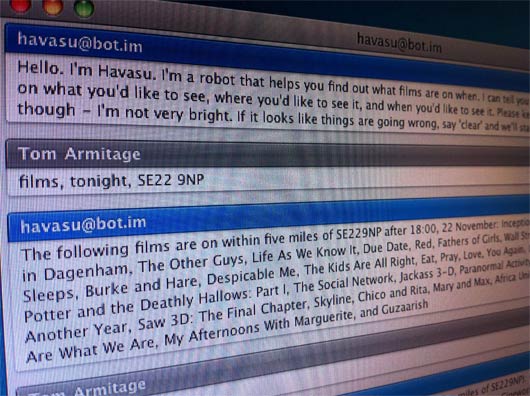
This November, I made a robot. It’s called Havasu.
Havasu is a robot that helps you find out what films are on when, and then organise your friends to go. You talk to Havasu through instant messenger.
The purpose of the project was to be a material exploration into conversational interfaces. The Havasu project page explains more:
The goal of the project was to explore ways of interacting that aren’t menus or GUIs; manners of interaction more like dialogue, or polite listening, facilitated by agents or AIs that are could not really be called “smart”. It’s very much in line with the notions of “Fractional AI” and “BASAAP” that we are interested in.
I’ve written about material exploration before. The previous explorations I’ve conducted in code were all about large datasets – TV listings for Shownar, schools for Schooloscope.
Havasu isn’t an exploration of data, though: it’s an exploration of a type of UI. We were seeking to define the qualities that defined a type of interaction – what made an interface conversational. Was it the use and understanding of natural language? Was it the way a conversation flowed? Was it that it was conducted in a more casual manner than an interface that constantly demands your full attention? The easiest way to find out these answers was to build our own conversational UI.
Havasu was built in three weeks. Matt W and I agreed on a fairly simple set of goals for the project:
- it had to be a conversational interface
- about film screenings
- that could be released publicly
You can talk to Havasu yourself. It’s available to any Jabber-compatible instant messanging client (such as Google Talk) as havasu@bot.im. It’s very much not a complete product; it has some rough edges, to say the least.
The material exploration within Havasu wasn’t just writing the code to build the bot: it was interacting with that interface, seeing where it succeeded and failed, and using what we’d learned by both making Havasu and playing with it to determine what makes an interface conversational.
The conclusions we came to – and the suggestions for how the Havasu bot could be improved – are on the Havasu project page.
No Comments or Trackbacks